 W
WThe 3 cm MK 303 Flak and twin-mounted 3 cm MK 303 Flakzwilling (M44) were experimental 30 mm anti-aircraft guns developed in Nazi Germany. They fired the powerful 30x210mm round and only 222 were produced. The gun was to be installed on Type XXI submarines as AA defense and its use as AA defense replacing 2 cm Flak and 3.7 cm Flak weapons was also considered. The use of 3 cm M.K. 303 Flakzwilling on Flakpanzer IV "Kugelblitz" was considered, but rejected. The development began in late 1941 and production started in late 1944.
 W
WThe 3.7 cm Flak M42 was the marine version of the 3.7-centimetre (1.5 in) Flak 36/37 and used by the Kriegsmarine on surface ships and as the M42U on Type VII and Type IX U-boats. The 3.7 cm Flak M42U used several types of mounts and entered service in autumn 1943.
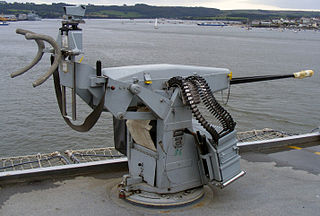 W
WThe Oerlikon 20 mm cannon is a series of autocannons, based on an original German Becker Type M2 20 mm cannon design that appeared very early in World War I. It was widely produced by Oerlikon Contraves and others, with various models employed by both Allied and Axis forces during World War II, and many versions are still in use today.
 W
WThe 20 mm modèle F2 gun is a naval defence weapon used by the French Navy. It was developed from the GIAT M693. It fires the 20×139 mm round originally developed for the Hispano-Suiza HS.820 series.
 W
WThe 30 mm/82 Compact is a naval autocannon built by Alenia Marconi Systems and Oto-Breda, using the Mauser MK 30 mm Model F gun.
 W
WThe 30mm DS30M Mark 2 is a ship-protection system made by MSI-Defence Systems consisting of a 30mm Mark 44 Bushmaster II cannon on an automated mount. It was designed to defend Royal Navy frigates from fast inshore attack craft armed with short-range missiles, rockets, rocket-propelled grenades, heavy machine guns or explosives. It replaced in this role the 30mm Oerlikon KCB gun on the DS30B, a similar powered mounting. The DS30M has also been added to patrol boats and corvettes for the Iraqi and Omani navies respectively.
 W
WThe Rheinmetall Oerlikon Millennium Gun or Rheinmetall GDM-008 is a close-in weapon system designed by Rheinmetall Air Defence AG for mounting on ships. It is based on the 35/1000 revolver gun land based air defense system, and uses AHEAD ammunition.
 W
WThe Bofors 40 mm gun, often referred to simply as the Bofors gun, is an anti-aircraft autocannon designed in the 1930s by the Swedish arms manufacturer AB Bofors. It was one of the most popular medium-weight anti-aircraft systems during World War II, used by most of the western Allies as well as some captured systems being used by the Axis powers. A small number of these weapons remain in service to this day, and saw action as late as the Persian Gulf War.
 W
WThe 45 mm anti-aircraft gun (21-K) was a Soviet design adapted from the 45 mm anti-tank gun M1932 (19-K). This was a copy of a 3.7 cm (1.5 in) German weapon designed by Rheinmetall that was sold to the Soviets before Hitler came to power in 1933 that had been enlarged to 45 mm (1.8 in) to reuse a large stock of old 47mm ammunition. It was used by the Soviet Navy to equip almost all of their ships from 1934 as its primary light anti-aircraft gun until replaced by the fully automatic 37 mm 70-K gun from 1942 to 1943. It was used in World War II and during the Cold War as the Soviets exported their World War II-era ships to their friends and allies. However it was not very effective as its slow rate of fire and lack of a time fuze required a direct hit to damage targets.
 W
WThe OTO Melara 76 mm gun is a naval gun built and designed by the Italian defence company Oto Melara. It is based on the Oto Melara 76/62C and evolved toward 76/62 SR and 76/62 Strales.
 W
WThe AK-100 is a Soviet 100mm naval cannon, with a maximum rate of fire of 60 rounds per minute, firing a 26.8 kg munition in HE anti-air or HE fragmentation varieties.
 W
WThe AK-130 is an automatic naval cannon with a caliber of 130 millimetres (5.1 in).
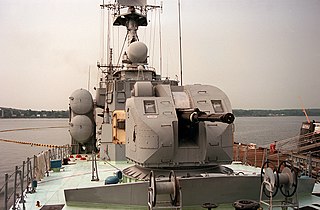 W
WThe AK-176 is a Soviet naval gun mounted in an enclosed turret, that may be used against sea, coastal, and aerial targets, including low flying anti-ship missiles. The system is designed to arm small displacement ships and comprises the Gun Mount with a MR-123-02/76 Fire Control Radar System. It has high survivability owing to autonomous use of the gun mount controlled from the optical sight in the absence of control from the radar system, as well as a capability for fire even if power supply is lost.
 W
WThe AK-230 is a Soviet fully automatic naval twin 30 mm gun. Its primary function is anti-aircraft. It is mounted in an enclosed automatic turret and directed by radar. AK-230 is widely used, mounted on big warships as well as small craft. About 1450 guns were produced in the USSR, and about 300 were produced in China as the Type 69. It was succeeded by the more powerful AK-630 from the mid-to-late 1970s.
 W
WThe AK-630 is a Soviet and Russian fully automatic naval close-in weapon system based on a six-barreled 30 mm rotary cannon. In "630", "6" means 6 barrels and "30" means 30 mm. It is mounted in an enclosed automatic turret and directed by MR-123 radar and television detection and tracking. The system's primary purpose is defense against anti-ship missiles and other precision guided weapons. However it can also be employed against fixed or rotary wing aircraft, ships and other small craft, coastal targets, and floating mines. Once operational, this weapon system was rapidly adopted, with up to 8 units installed in every new Soviet warship, and hundreds produced in total.
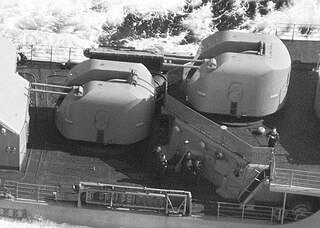 W
WThe AK-726 is a double-barreled naval gun of 76.2 mm caliber, which was developed in the Soviet Union and is still in service in various navies.
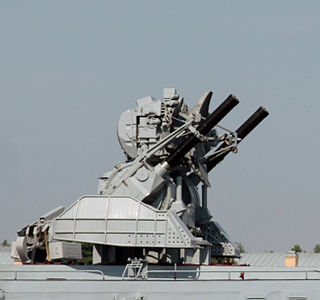 W
WA close-in weapon system is a point-defense weapon system for detecting and destroying short-range incoming missiles and enemy aircraft which have penetrated the outer defenses, typically mounted shipboard in a naval capacity. Nearly all classes of larger modern warships are equipped with some kind of CIWS device.
 W
WDARDO is a close-in weapon system (CIWS) built by the Italian companies Breda and Oto Melara. It is composed of two Breda-built Bofors 40 mm firing high explosive (HE) shells, a fire-control radar (RTN-10X) and a fire-control system. It is the last of a long series of Italian anti-aircraft weapons derived from the Swedish Bofors 40 mm autocannons.
 W
WThe Denel 35mm Dual Purpose Gun (35DPG) is a close-in weapon system (CIWS) for warships built in South Africa by Denel Land Systems. It is currently in service on the Valour-class frigates of the South African Navy.
 W
WShip gun fire-control systems (GFCS) are analogue fire-control systems that were used aboard naval warships prior to modern electronic computerized systems, to control targeting of guns against surface ships, aircraft, and shore targets, with either optical or radar sighting. Most US ships that are destroyers or larger employed gun fire-control systems for 5-inch (127 mm) and larger guns, up to battleships, such as Iowa class.
 W
WGoalkeeper is a Dutch close-in weapon system (CIWS) introduced in 1979. It is an autonomous and completely automatic weapon system for short-range defence of ships against highly manoeuvrable missiles, aircraft and fast-manoeuvering surface vessels. Once activated the system automatically undertakes the entire air defence process from surveillance and detection to destruction, including the selection of the next priority target.
 W
WThe Kortik close-in weapon system (CIWS) is a modern naval air defence gun-missile system deployed by the Russian Navy. Its export version is known as Kashtan, with the NATO designation CADS-N-1 Kashtan.
 W
WNaval anti-aircraft guns include anti-aircraft guns specially designed or adapted for mounting on ships, and naval guns adapted for high-angle fire. Today they have been largely superseded by surface-to-air missiles and automatic close-in weapon systems.
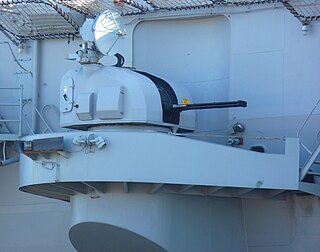 W
WThe Meroka CIWS is a Spanish Navy 12 barrelled 20 mm CIWS, using twelve Oerlikon 20 mm/120 guns mounted in 2 rows of 6 guns each. The system's primary purpose is defence against anti-ship missiles, and other precision guided weapons. However it can also be employed against aircraft, ships and other small craft, coastal targets, and floating mines. The weapon is mounted primarily on Spanish naval vessels, from frigate size upwards.
 W
WThe Oerlikon 30 mm twin cannon is an anti aircraft gun used by the Royal Navy. They were fitted to Type 42 destroyers after the Falklands War to improve defence against air attack.
 W
WPantsir-M is a Russian jamming-resistant naval close-in weapon system (CIWS) which entered service in 2018. Pantsir-M is equipped with friend or foe identification system and armed with naval version of the Pantsir's 57E6 missiles and Hermes-K missiles. Its secondary armament are two six-barreled 30×165mm GSh-6-30K/AO-18KD rotary cannons. Same as on Kashtan-M. Pantsir-M is fully automated and can engage up to four targets simultaneously at a range of up to 20 km and can operate as a battery of up to four modules. Pantsir-M can intercept sea skimming missiles flying as low as two meters above the surface. If a target isn't sufficiently destroyed by Pantsir's missile attack it can automatically direct its cannons against it. Pantsir-M's phased array radar, electro-optical/infrared targeting and identification system are based on that of Pantsir's 1RS2-1.
 W
WThe Phalanx CIWS is a close-in weapon system for defense against incoming threats such as small boats, surface torpedoes, anti-ship missiles and helicopters. It was designed and manufactured by the General Dynamics Corporation, Pomona Division, later a part of Raytheon. Consisting of a radar-guided 20 mm (0.8 in) Vulcan cannon mounted on a swiveling base, the Phalanx has been used by the United States Navy and the naval forces of 15 other countries. The US Navy deploys it on every class of surface combat ship, except the Zumwalt-class destroyer and San Antonio-class amphibious transport dock. Other users include the British Royal Navy, the Royal Australian Navy, the Royal Canadian Navy and the US Coast Guard .
 W
WA plotting room was the co-ordination centre of a fire control system for guns used against enemy ships or aircraft, whether naval guns or coastal artillery. The plotting room received data on ship or aircraft position and motion from fire control instruments or their operators and determined and transmitted the range and bearing the guns would fire on. Plotting rooms came into use in the early 1900s for coastal artillery and during World War I for warships as gun ranges increased, and were in general use through the 1970s on World War II-era ships. Warships had plotting rooms for naval fire control for guns from 5-inch to 18-inch calibre, including anti-aircraft use for the smaller guns. On armoured ships such as battleships and cruisers, plotting rooms were located in the armoured citadel, protected by both deck and belt armour. With a few exceptions, coastal defence gun installations were inactivated shortly after World War II (US) through the middle 1950s (UK). Equipment in plotting rooms included specialised plotting boards and other analogue devices; by World War II these were supplemented or replaced by electro-mechanical gun data computers. Data could be received and transmitted by telephone, or directly via dedicated electrical systems. Locations of plotting rooms in coastal defence installations varied greatly; they could be in low-rise structures such as base end stations, taller fire control towers, in gun battery structures, or in bunkers separate from gun batteries.
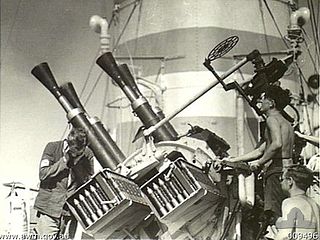 W
WThe 2-pounder gun, officially designated the QF 2-pounder and universally known as the pom-pom, was a 40-millimetre (1.6 in) British autocannon, used as an anti-aircraft gun by the Royal Navy. The name came from the sound that the original models make when firing. This QF 2-pounder was not the same gun as the Ordnance QF 2 pounder, used by the British Army as an anti-tank gun and a tank gun, although they both fired 2-pound (0.91 kg), 40-millimetre (1.6 in) projectiles.
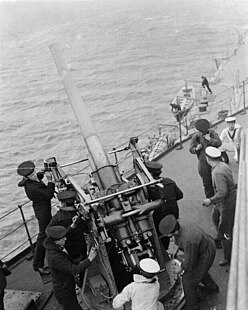 W
WThe QF 3 inch 20 cwt anti-aircraft gun became the standard anti-aircraft gun used in the home defence of the United Kingdom against German airships and bombers and on the Western Front in World War I. It was also common on British warships in World War I and submarines in World War II. 20 cwt referred to the weight of the barrel and breech, to differentiate it from other "3 inch" guns. While other AA guns also had a bore of 3 inches, the term "3 inch" was only ever used to identify this gun in the World War I era, and hence this is what writers are usually referring to by "3 inch AA gun".
 W
WThe Ordnance QF 3-pounder Vickers was a British artillery piece first tested in Britain in 1903. It was used on Royal Navy warships. It was more powerful than and unrelated to the older QF 3-pounder Hotchkiss, with a propellant charge approximately twice as large, but it initially fired the same Lyddite and steel shells as the Hotchkiss.
 W
WThe QF 4 inch Mk V gun was a Royal Navy gun of World War I which was adapted on HA mountings to the heavy anti-aircraft role both at sea and on land, and was also used as a coast defence gun.
 W
WThe QF 4 inch Mk XVI gun was the standard British Commonwealth naval anti-aircraft and dual-purpose gun of World War II.
 W
WThe QF 4.5 inch gun has been the standard medium-calibre naval gun used by the Royal Navy as a medium-range weapon capable of use against surface, aircraft and shore bombardment targets since 1938. This article covers the early 45-calibre family of guns up to the 1970s. For the later unrelated 55-calibre Royal Navy gun, see 4.5 inch Mark 8 naval gun.
 W
WThe QF 4.7 inch Gun Mark VIII was a British naval anti-aircraft gun designed in the 1920s for the Royal Navy. This was the largest caliber fixed ammunition gun ever in service in the RN, though the round was considerably shorter and lighter than the round for the QF 4.5-inch Mk I – V naval gun. It was carried in powered HA XII mountings on the two Nelson-class battleships, two of the three Courageous-class aircraft carriers, the minelayer HMS Adventure, and the Australian seaplane tender HMAS Albatross.
 W
WThe 4.7 inch QF Mark IX and Mark XII were 45-calibre, 4.7-inch (120 mm) naval guns which armed the majority of Royal Navy and Commonwealth destroyers in World War II, and were exported to many countries after World War II as the destroyers they were mounted on were sold off.
 W
WThe 4.7 inch QF Mark XI was a 50-calibre, 4.7-inch (120 mm) naval gun deployed on Royal Navy (RN) and Allied destroyers during World War II.
 W
WThe QF 5.25-inch Mark I gun was the heaviest dual-purpose gun used by the Royal Navy during the Second World War. Although considered less than completely successful, it saw extensive service. 267 guns were built.
 W
WThe QF 6-inch Gun Mark N5 was a British naval gun, which was developed in the post-war period. It was the last large gun to be operational with the Royal Navy.
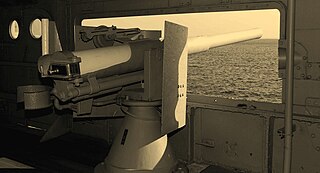 W
WThe QF 12-pounder 12-cwt gun was a common, versatile 3-inch (76.2 mm) calibre naval gun introduced in 1894 and used until the middle of the 20th century. It was produced by Armstrong Whitworth, Elswick and used on Royal Navy warships, exported to allied countries, and used for land service. In British service "12-pounder" was the rounded value of the projectile weight, and "12 cwt (hundredweight)" was the weight of the barrel and breech, to differentiate it from other "12-pounder" guns.
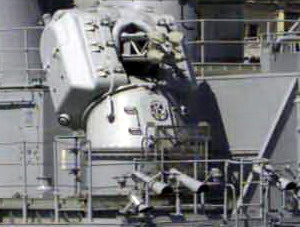 W
WSea Zenith is a four-barrelled 25 mm CIWS used by the Turkish Navy on their MEKO 200 frigates, like the Barbaros and Yavuz classes. It was developed in the 1980s by Oerlikon Contraves around their Oerlikon KBB gun and manufactured in Switzerland. This automatic gun uses a 25x184mm cartridge at a rate of 800 rounds a minute. Using four independent guns instead of one multi-barrelled rotary cannon improves reliability. The system is mounted in an enclosed automatic turret and directed by the Seaguard radar developed by Contraves. The turret is tilted back to allow a higher elevation to intercept diving missiles. The system's primary purpose is defence against anti-ship missiles, and other precision guided weapons. However it can also be employed against fixed/rotary wing aircraft, ships and other small craft, coastal targets, and floating mines.
 W
WThe Škoda 7 cm K10 was a dual-purpose gun of the Austro-Hungarian Empire that was used by the Austro-Hungarian Navy during World War I. The gun was actually 66 mm, but the classification system for artillery rounded up to the next highest centimeter. The 7 cm K10 was also used by the Italian Navy on ships ceded as war reparations and as coastal artillery during World War II. The Italians referred to it as the 66/47.
 W
WThe Type 10 or 12 cm/45 10th Year Type naval gun was a Japanese 120 mm calibre dual purpose anti-aircraft and coastal defense gun used during the Second World War. It was derived from the 12 cm/45 3rd Year Type naval gun. The Type 10 number was designated for the year the gun was accepted,the 10th year of Emperor Taishō's reign, 1927 in the Gregorian calendar. It served as the secondary armament on a number of Japanese aircraft carriers and cruisers and as the main armament on smaller ships, in single or twin mountings.
 W
WThe Type 61 25mm AAA gun is an anti-aircraft gun produced and used by China. It is manually operated by a single crew with an optical sight. The development began in 1961 and the batch production began in 1966. There were both land based and naval variants produced.
 W
WThe Type 730 is a Chinese seven-barrelled 30 mm Gatling gun CIWS. It has a PLA Navy designation H/PJ12. It is mounted in an enclosed automatic turret and directed by radar, and electro-optical tracking systems. The maximum rate of fire is 5800 rd/m, and the effective range is up to 3 km.